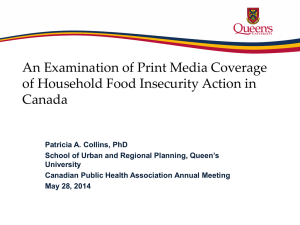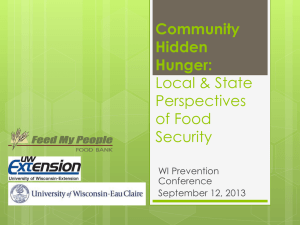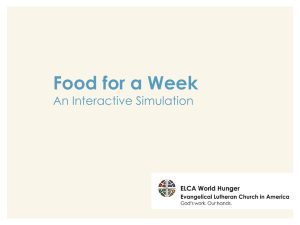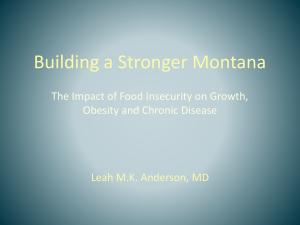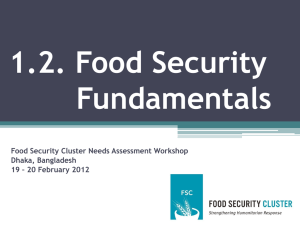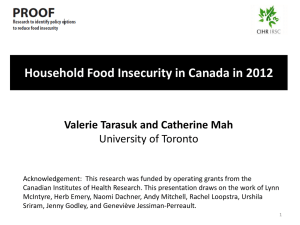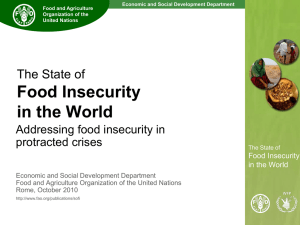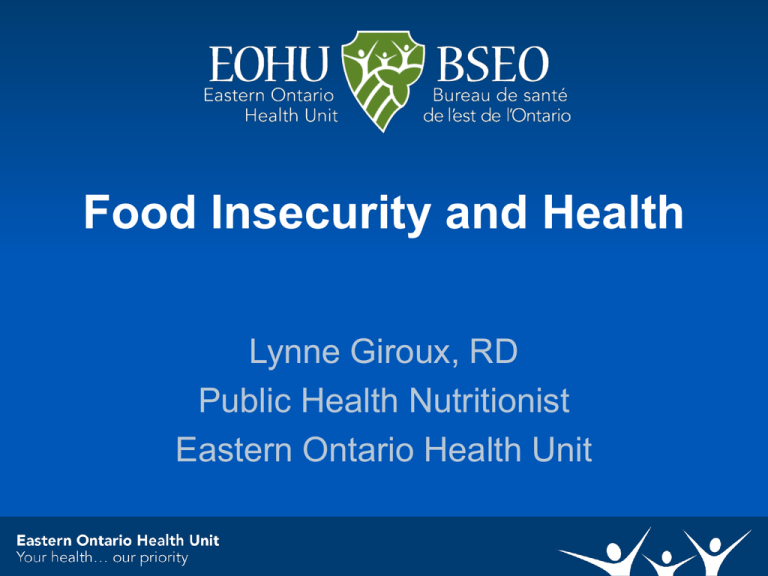
Food Insecurity and Health
Lynne Giroux, RD
Public Health Nutritionist
Eastern Ontario Health Unit
Food security exists when...
“all people, at all times, have physical and economic
access to sufficient, safe and nutritious food to meet
their dietary needs and food preferences for an
active and healthy life” Food and Agriculture
Organization (FAO) of the United Nations
Household
food
insecurity
in Canada
(Tarasuk,
Mitchell, &
Dachner,
2014, p. 4)
Household
food
insecurity
by
province &
territory
(Tarasuk, Mitchell, & Dachner, 2014, p. 2)
Household food
insecurity in Ontario
(Tarasuk, Mitchell, & Dachner, 2014, p. 9)
Determinants of Food Insecurity: Income
• Having an income below the Low Income Measure (29.0% are food
insecure).
Unpublished analysis of 2011
Canadian Community Health
Survey data, as cited in
PROOF. Retrieved from:
http://nutritionalsciences.lamp.u
toronto.ca/food-insecurity/
Determinants of Food Insecurity
Sources of income
– Food insecurity affected 69.5% of Canadian households reliant on
social assistance (i.e., welfare and disability support programs).
– 58.3% (62.2% Canada) of food insecure households were reliant on
wages and salaries.
Housing
– Renting rather than owning one’s home (26.1% were food insecure
vs. 6.4% of homeowners) (Tarasuk, Mitchell, & Dachner, 2014).
Education
– Less than secondary (21% food insecure)
– Completed a Bachelor’s degree or higher (6.3%) (Tarasuk, Mitchell, &
Dachner, 2014).
Determinants of Food Insecurity: Household Composition
(Tarasuk, Mitchell, & Dachner, 2014, p. 9)
Chronic Diseases: A Public Health Priority
• Most significant cause of death (63%) worldwide1 [1].
• Chronic diseases increase income inequities, deplete household
wealth, increase health spending and lower labour productivity [2].
• Chronic diseases cause premature deaths under age 60: 13% in
high income countries like Canada [1].
• Chronic disease rates are increasing at 14% each year [3].
• 3 out of 5 Canadians older than 20 have a chronic disease; and
• 4 out of 5 are at risk [3].
[1] World Health Organization 1Except in sub-Saharan Africa
[2] World Bank, 2011
[3] Centre for Chronic Disease Prevention and Control, Public Health Agency of Canada, using POHEM
Model, Statistics Canada.
Impact of Food Insecurity on Health
Poverty
Food
Insecurity
Poor
Health
Impact of Food Insecurity on Health
Chronic conditions such as… [1]
• diabetes
• heart disease
• hypertension
• depression
• fibromyalgia
Household food insecurity also affects people’s ability to
manage chronic health problems [1].
[1] 5-10 as cited in Tarasuk, Mitchell, & Dachner, 2014.
Impact of Food Insecurity on Health
• mental health
– feelings of anxiety (anxiety disorders), depression,
distress, stress, and suicidal tendencies
– social isolation and alienation
– eating disorders
• well-being/social health
– impaired ability to work and learn
• physical health
• oral health
Source: 5-10 as cited in Tarasuk, Mitchell, & Dachner, 2014; Dietitians of Canada, 2012
Impact of Food Insecurity on Health: Children
Causal evidence that children and youth who experienced hunger,
especially repeated hunger [1]:
- were more likely to have poorer health, and
- were more likely than others to have developed several chronic
health conditions, including asthma.
[1] Tarasuk, Mitchell, & Dachner, 2014.
Impact of severe food insecurity
• The prevalence of severe food insecurity in Ontario (2.7%) is above the
national prevalence (2.6%).
• In 2012, 29.4% of households who reported their main source of income
as social assistance were severely food insecure.
(Tarasuk, Mitchell, & Dachner, 2014, p. 14)
Impact of Food Insecurity on Nutrition
Food Insecurity is associated with...
• A less varied diet [1],
• A lower intake of fruits and vegetables [1],
• A lower intake of milk and alternatives [3],
[1] Gorton, Bullen, and Mhurchu, as cited in Conference Board of Canada, 2015.
[2] Cummins and Macintyre, as cited in Conference Board of Canada, 2015.
[3] Kirkpatrick and Tarasuk, 2008, as cited in PROOF. Retrieved from:
http://nutritionalsciences.lamp.utoronto.ca/food-insecurity/
Impact of Food Insecurity on Nutrition
Food Insecurity is associated with...
• Malnutrition [1]
• An increased consumption of processed foods (i.e.,
higher intakes of sodium, trans fat, and sugar) [2]
• An increased risk of inadequate nutrient intakes
[1,3]
[1] Gorton, Bullen, and Mhurchu, as cited in Conference Board of Canada, 2015.
[2] Cummins and Macintyre, as cited in Conference Board of Canada, 2015.
[3] Kirkpatrick and Tarasuk, 2008, as cited in PROOF. Retrieved from:
http://nutritionalsciences.lamp.utoronto.ca/food-insecurity/
EOHU
• Nutritious Food Basket
• SDOH PHN – partnerships
to address income and
poverty
• ATF collaborative
member/partner
• GFB partnerships
• Directory of Local Food
Programs and Services
Household food
insecurity in the
Eastern Ontario Region
Nutritious Food Basket Data
• Family of four, EOHU, 2014: $195.85
• Family of four, EOHU, 2013: $186.66
• Family of four, EOHU, 2012: $190.38
• Family of four, EOHU, 2011: $181.66
• Family of four, EOHU, 2010: $173.19
• Family of four, EOHU, 2009: $171.02
This has been a presentation by the
Eastern Ontario Health Unit.
©EOHU. All rights reserved.

